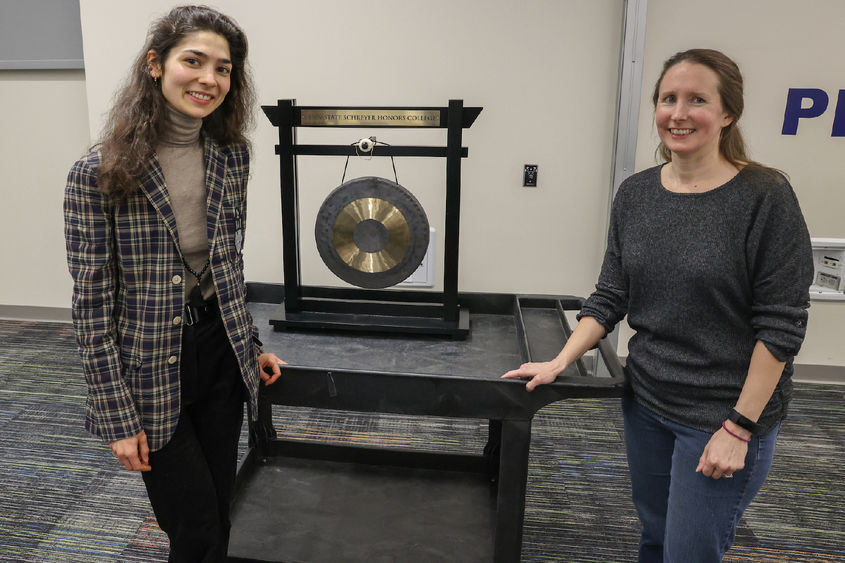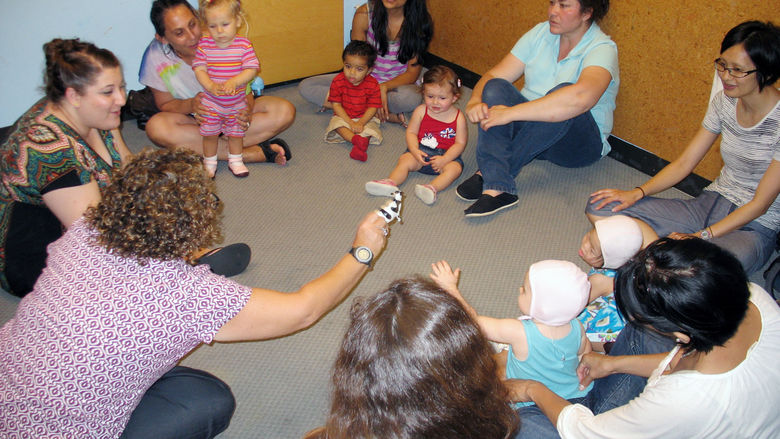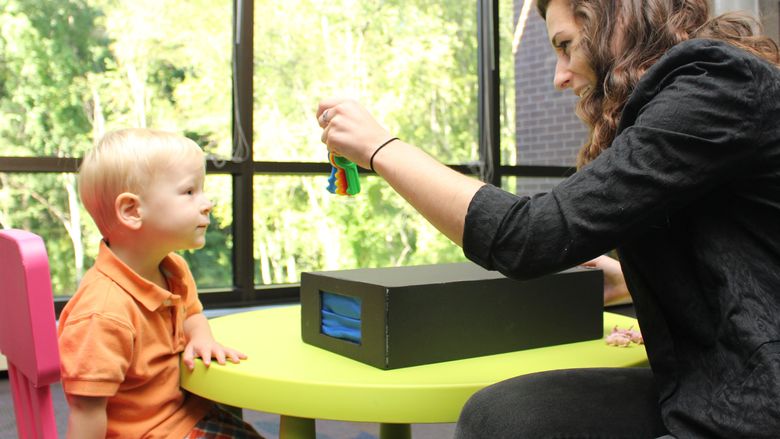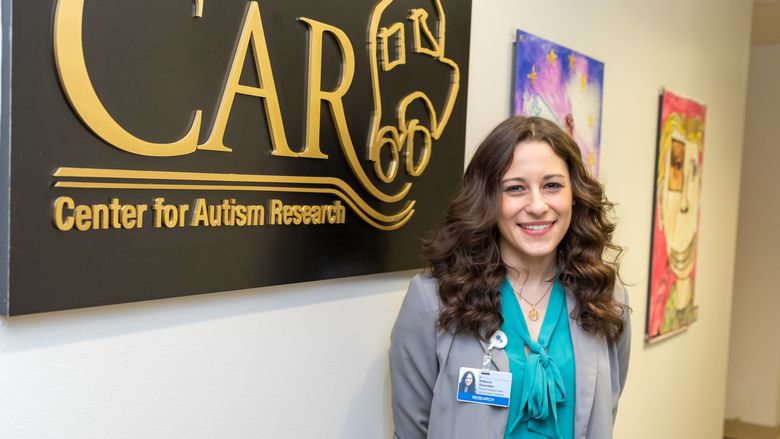
Nora Margulis, left, and Anna Sigmon, right, after defending her thesis in Dec. 2022.
MEDIA, Pa. — Penn State alumna Nora Margulis, who graduated in 2022, was still taking her courses virtually in spring of 2021, working toward her undergraduate degree in biology at Brandywine when Anna Sigmon, assistant professor of chemistry, offered her the opportunity to collaborate on research that could potentially help society cope with the ongoing COVID-19 pandemic. She jumped at the chance.
Now, two and half years later, Margulis has graduated and earned a co-authorship on the project, published in Results in Chemistry. The paper, which was included in the journal’s special issue titled “Recent Advances in Organic Chemistry,” was also co-authored by Hamzah Al-Quaid, another Brandywine alumnus; Neela Yennawar, research professor and director of the X-Ray Crystallography and Automated Biological Calorimetry Core Facilities, Tatiana Laremore, associate research professor and director of the Proteomic and Mass Spectrometry Core Facility, and Julia Fecko, research technologist in the X-Ray Crystallography Core Facility, all with the Huck Institutes of the Life Sciences; and Christy George, assistant research professor in the Eberly College of Science.
The paper details their work developing derivative compounds from flavonoids — molecules found in plants that have medicinal uses — to inhibit an enzyme of SARS-CoV-2, the coronavirus that gives rise to COVID-19. The enzyme, called the papain-like protease, breaks down proteins and helps the virus replicate. It also prevents the host’s immune system from responding properly. The work to inhibit this enzyme, the researchers said, could inform future treatments for the virus.
“Throughout the course of my undergraduate experience, I became involved in research with Dr. Sigmon through organic synthesis,” Margulis said when reflecting on how she became involved in the project. “I was very fortunate to have my academic adviser, Dr. Elizabeth Dudkin, associate professor of biology, communicate with Dr. Sigmon and recommend me for research.”
Sigmon, Margulis’ honors adviser, said she became interested in the idea that flavonoids could contribute to COVID-19 treatments at the start of the pandemic and began conducting computational research with the students virtually.
“In general, my research has been focused on flavonoids," Sigmon said. "I’ve always been interested in looking at flavonoids and making new derivatives from them, so when I found out that there was a derivative that could inhibit the coronavirus, I wanted to examine this further."
Margulis described what the research entailed while working virtually.
“During the remote phase of the COVID-19 pandemic, specifically in the spring semester of 2021, my research included computational analyses and literature exposure to flavonoids and their biological implications,” Margulis said. “During the summer that same year, we became more involved in laboratory experimentation, trying different synthetic reactions to create something novel and test those products for biological significance.”
The researchers analyzed different derivatives using computer simulation software to identify which ones could possibly inhibit the protease. They identified 10 derivatives with potential, but their syntheses were challenging due to instability of the products. To improve the derivatives, the researchers changed the structure of the products to include a hydrazone linker, or a chemical compound, that can help make molecules more stable.
Using AutoDock Vina, a virtual molecular docking program, the research team simulated how the compounds might bind — or dock — to the protease. The researchers then synthesized the compounds in the lab and characterized them using nuclear magnetic resonance, mass spectrometry and x-ray crystallography. From the docking research, the researchers found that the binding energies in the compounds were promising — in some cases, more promising than the binding energies of known COVID-19 inhibitors.
“Since this paper was a culmination of all of my undergraduate research efforts and depicted data from computational analyses to synthetic reactions to the analytical data from our collaborators, I greatly enjoyed seeing the finalization of the paper,” Margulis said. “Much of the data was preliminarily explained in my honors thesis, so seeing Dr. Sigmon tie together all of these elements was very fulfilling.”
Margulis mentioned how she experienced personal growth through her research with Sigmon, as she became more comfortable working in a laboratory setting.
“On a personal level, I definitely got a sense of closure from the research that I participated in, at least in the questions we aimed to answer,” Margulis said. “I also uncovered some personal characteristics, such as being comfortable with failures and unsatisfactory results, and I became far more confident as a student. With regard to individual skills, I undeniably became more independent and comfortable in the lab and with my role in it. I also acquired an irreplaceable relationship with Dr. Sigmon, who instilled me with the confidence to explore many different experimental options truly and creatively.”
Sigmon said the most valuable part of her research with Margulis was the experience it gave to one of her undergraduate students, as she was able to see the different aspects of the research process and collaborate with researchers from another campus.
“The primary purpose of my research program is to teach and enrich the academic experiences of my undergraduate students,” she said.
“Research can be a life-transforming experience for students, and is critical for student retention in STEM, especially for students from underrepresented groups. On the practical side, it prepares students for jobs. I've had former students tell me that their research with me is what helped them to obtain and succeed in a job after graduation.”
Since graduating from Penn State, Margulis has accepted a position as an assistant scientist at Resolian, a pharmaceutical and drug development company.
The Cooper Memorial Faculty Fellowship from Penn State Brandywine and the Penn State’s Commonwealth Campuses Research Collaboration Development Program supported this work.




